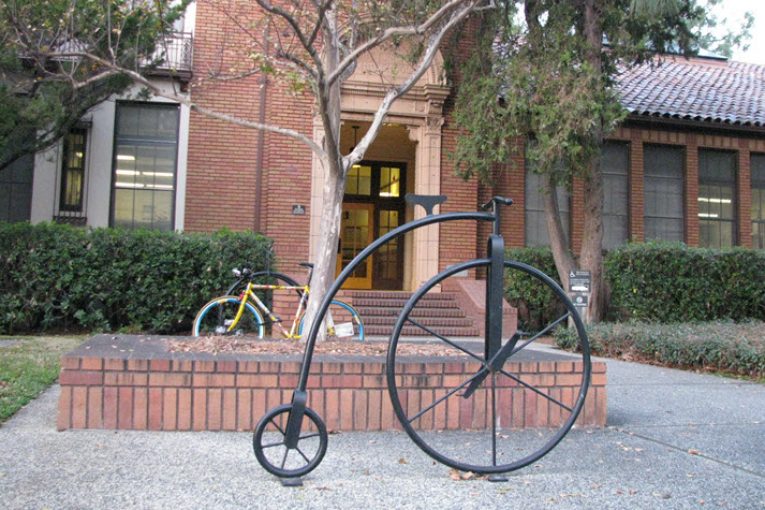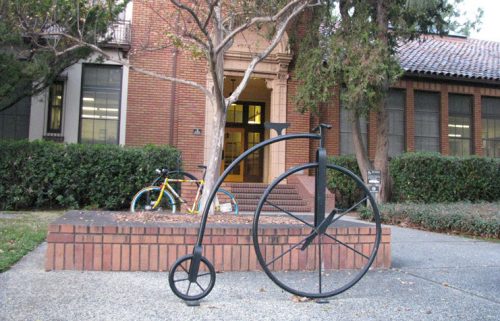

By Melanie Johnson
DAVIS, CA – On Monday night, the Davis Natural Resources Commission (NRC) continued their ongoing debate regarding which actions of the city’s Climate Action and Adaptation Plan (CAAP) they intend to recommend to City Council as top priorities and the process by which these items should be implemented.
Due to time constraints, the commission decided to appoint a subcommittee to produce a consolidated summary of their discussion and finalize their recommendations regarding the current CAAP priority list, to be presented to City Council on May 24.
NRC Chair Margaret Slattery opened the discussion by stating that the meeting’s primary goal in forming a recommendation to City Council was to highlight “especially important” CAAP actions while keeping in mind “that doing all of them barely gets us to reaching the goals” set by the CAAP.
Commissioner Thomas Rost proposed greenhouse gas (GHG) emission reduction strategies involving transportation as a primary target for the city’s efforts.
He explained that previous analyses presented to the NRC conveyed that “two-thirds of the greenhouse gas emissions are coming from cars driving through town.” Rost added that “it seems to me that the top of the list must be anything that’s going to help . . . directly reduce greenhouse emissions from that source.”
Accordingly, Rost identified specific CAAP actions, such as “changing the city fleet to electric, reducing traffic, incentivizing electric bicycles, and all of the things like that” as items that “need to be the highest priority.”
Commissioner Richard McCann directed the commission’s attention to the fact that “the city has limited resources.” He advised that the NRC keep in mind the questions: “What do we want to do with the limited resources we have? Where’s the biggest bang for, not the dollar impact, but our effort impact, including what city staff can do and what the city can do that way?”
McCann added that “one of the things that we can best communicate to the City Council is, ‘You folks have limited resources; here’s where you need to focus first . . . because you can’t do all of them.’”
Slattery agreed, “I do think we should be trying to converge around recommendations that we think are the biggest bang for the buck in terms of effort,” but qualified that “we probably won’t have consensus maybe on which transportation measures.”
NRC Vice Chair John Johnston suggested that prioritization of actions may not be the best use of the NRC’s efforts.
He reminded the commission, “We’ve ended up here with thirty some-odd priority actions and we’ve added them up the best we could, and we found that we really need to do all of them.”
Johnston explained, “I really think that it’s not so much an issue of which ones to do and which not to do, it’s a matter of perhaps which ones to do first, and which ones to maybe get started because they’re going to take a long time, and then, which ones we’ll have to get around to when we can or when we can afford to.” He also urged the commission not to conflate the GHG emission reduction actions that Davis is responsible for with those that the state is responsible for.
Johnston stated, “The amount of credit that we are taking for emission reductions due to the vehicle standards being promulgated by the state, is approximately equal to the amount that all 30 of our actions add up to.” He asked that the NRC ensure “that those actions do really apply to Davis and are really taking us where we would like to go.”
Johnston also offered some prioritization principles the commission could adopt instead of debating individual items. He advised the prioritization of “actions that save money,” “actions that are solely city actions that can be done at the city level and not . . . by the citizens or other agencies,” “items involving new construction,” and finally, “items that will take a long time to accomplish.”
McCann suggested as an alternative, “I think that we should prioritize the biggest [CAAP action items] . . . And conversely, if there’s a relatively small emission reduction coming from a measure, and there aren’t other mitigation measures coming from that, we probably should not prioritize that.”
However, Johnston cautioned, “I think it’s important to get after some quick wins even if they’re relatively small to build some social momentum here. If we hold out and put all of our efforts into this big giant thing that is going to take us forever to accomplish, we might miss a lot of things along the way.”
Rost also added that in terms of overall implementation, “There has to be broader coordination in all the aspects in this plan. It can’t be Davis alone; it’s got to be the region. I think that should be specifically stated in the plan.”
Leilani Buddenhagen, representing the Senior Citizen Commission, drew the NRC’s attention to the costs associated with some of the CAAP items.
She cited a CAAP mandatory paid parking initiative as an example, stating, “if driving downtown in a personal vehicle would become disincentivized, then it would be important to have some sort of alternative that would be as similarly convenient that would take people door-to-door.”
Buddenhagen further emphasized, “I think that the ability to . . . really evaluate different items and to be able to recommend them, it really requires looking at the other impacts, the other benefits or detractors that might occur, especially along the lines of equity, inclusion, making housing less affordable, or harder to get into or out of . . . All of those things seem to be really important pieces to evaluate in considering whether or not to move forward.”
However, McCann countered these concerns and argued that implementation of CAAP actions “is actually an existential question.”
He emphasized to the commission that “we actually have to pursue all of these measures to the maximum extent possible” regardless of the potential consequences, which he argued could be mitigated separately.
He explained, “If we, for example, have a problem with making housing unaffordable, we have to figure out income measures in order to mitigate that cost; not avoid the [CAAP] measures because they cause an increase in the cost of housing.”
Keeping in mind all of these points of discussion, the NRC opted to appoint a subcommittee to summarize their meeting and present this summary to City Council for their consideration.
Councilmember Dan Carson concluded, “I’m very happy about the process that has unfolded here . . . I appreciate that you all came back . . . to work through these very complicated issues. I personally find that the comments I’m hearing, and the guidance . . . will be very helpful for me and I’m sure it will be so for my colleagues.”
Update: Added clarification to the second paragraph about the nature of the subcommittee






The city is definitely “uncertain” about its climate action priorities, as demonstrated by their implied (or explicit) support for DiSC.
(Actually, I would call the impact of that “certain”.)
For that matter, some on the NRC (as well as one member of the Open Space and Habitat Commission) seem “uncertain” regarding their priorities (or purpose, for that matter).
Perhaps applies to some other members of other commissions, as well.
That is, unless they actually oppose what their respective commissions’ supposedly purpose is in the first place. (Perhaps depends upon “who” recommended and appointed them.)
The costs of these proposals need to be evaluated by a separate commission or agency.
Increased costs of housing and any implications for economic development need to be addressed. Various sources of funding are mentioned but not described in sufficient detail.
I suggest that “B.8 Revisit most recent parking pricing study (Downtown Paid Parking, City Council March 5, 2019) and implement pilot projects to test their effectiveness.” be pulled from consideration as that has already been basically rejected by the council.
Funding for “B.5 Subsidize public transit so it is free for all to use” needs to be identified.
https://www.cityofdavis.org/home/showpublisheddocument/16627/637727698494330000
Unfortunately, this completely mischaracterizes what happened at the meeting. The NRC had formed a cohesive set of recommendations but it didn’t have the time to write up a summary statement. A subcommittee was appointed to prepare a summary document of those recommendations (I am on that subcommittee), and we were able to quickly prepare that and get it back to the City Staff for inclusion in its Staff Report to the Council for its meeting May 24.